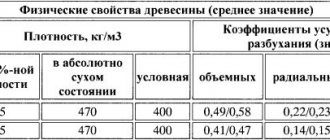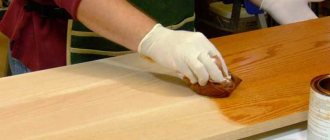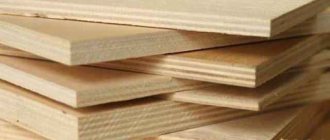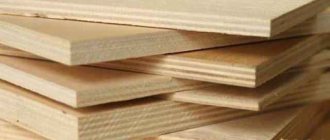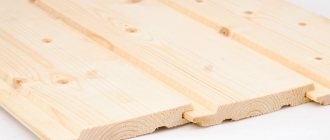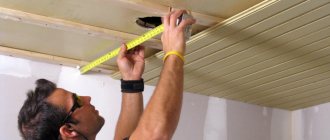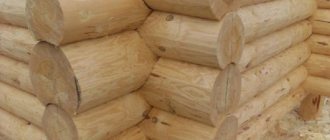Last year I sheathed my two-story bathhouse. There are four rooms on the first and second floors: a living room, a cold sink, a steam room, and a bedroom.
It was necessary to choose lining for 4 different surfaces:
- veranda (outside);
- bedroom, living room (inside), walls and ceiling;
- sink (inside), walls and ceiling;
- steam room, walls, ceiling, shelves.
The most inexpensive lining is pine. This one was used for external walls (veranda, lower roof slopes).
A story from my reader Valentin.
Larch bathhouse
When choosing a material for a bathhouse, you need to take into account not only the heat capacity of wood, but also other characteristics. Unlike a residential building, the wood here is exposed to intense exposure to steam, water and temperature fluctuations, because the building is heated only during bathing. Not every material can withstand such a load.
An excellent option for a bathhouse is larch. The tree is a coniferous tree, meaning it contains a fairly large amount of resin. High resin content ensures amazing resistance of larch to rot, fungi, and water.
If the products are made of pine, it is necessary to varnish and protect them from moisture. Larch does not need this. On the contrary, over time it only becomes stronger than oak.
The advantages of wood are not limited to unique resistance to decay. Accordingly, a larch bathhouse will have the following features:
- strength - the density of larch is only slightly less than that of oak, a structure made from this tree will last a long time, as it is not subject to mechanical damage;
- resistance to rain, snow and heat ensures the longevity of the bath;
- larch lining includes a small number of knots, and this means not only aesthetics, but also greater strength of the boards and logs themselves;
- the wood has a beautiful texture and is very attractive;
- a log bathhouse made of larch does not require any protective measures; there is no need for periodic treatment with antiseptics, insect repellents, or stains;
- lining made from this material has the same advantages as logs.
There are also disadvantages to a bathhouse made of larch:
- it is at least 2 times more expensive than pine;
- wood is processed with some difficulty, so the bathhouse itself will also cost more.
Comment! Larch floors are still used in European castles. Its age reaches 300–400 years.
Choosing a lining for a steam room
The walls and ceiling of this room are lined with the highest quality clapboard. It perfectly withstands high temperatures, high humidity, as well as constant exposure to water and steam. In order for the lining of the bathhouse with clapboard inside to be successful, you need to take care of the quality of the material in advance.
Knowing the technical characteristics of different types of trees, you can easily decide which lining to choose for the steam room. Of course, the best option is panels made from deciduous trees, since coniferous trees will release toxic resins when exposed to high temperatures.
Aspen bathhouse: pros and cons
If larch is used both as the main material and as a finishing material for the steam room, then with aspen the situation is different. This tree is very specific and not cheap. Moreover, the cost is determined not by high qualities, but by the features of the workpiece.
Aspen grows in wetlands, which causes the inside of the trunk to rot. You can only harvest aspen tops up to 4–5 m in length. The rest of the tree is unusable and is simply thrown away. In addition, aspen harvesting is only possible from March to May, while aspen is relatively easy to process. This “seasonality” makes the collection and supply of material a very expensive endeavor.
And yet, this is the material that people often prefer to linden and alder. In fact, the disadvantages of aspen turn into advantages when it comes to the steam room:
- aspen - hardwood, boards or lining from it do not emit resin, which is a valuable quality for a sauna;
- wood does not heat up as much as many other species, this eliminates the possibility of burns;
- out of 3 trunks, only one turns out to be suitable for construction, but it is extremely resistant to moisture and does not rot;
- wet aspen is easy to process; when dried, it shrinks greatly, but at the same time the tree acquires exceptional strength.
An aspen bathhouse lasts for decades, and over time it only becomes stronger.
Important! Aspen wood is very wet and shrinks greatly when dried. However, once it dries, it becomes rock hard.
Types of lining profiles
In addition to the fact that different wood is used in manufacturing, the lining may also differ in type of execution:
- Eurolining for a bathhouse is a popular type with recesses that emphasize the structure of the wall due to deep seams.
- Seamless lining forms a continuous wall due to very narrow seams.
- Imitation timber creates the illusion of a flat log wall.
- The blockhouse, due to its convex shape, creates a classic wall of semicircular logs.
Linden or aspen for a bath: which is better?
It's really difficult to choose between these two materials. Linden is traditionally considered the best tree for a bathhouse and deservedly so. However, aspen, despite its external ugliness, poses serious competition to it.
Linden wood is soft, it is easy to process, and accordingly, the construction of a bathhouse requires less cost. If dried logs were used, the building does not shrink and can be used immediately after completion of construction.
Aspen, on the contrary, is processed with great difficulty. Since a bathhouse requires well-dried material, this makes construction an expensive and time-consuming task.
The softness of linden is also its disadvantage - the tree is short-lived, but dry aspen acquires the hardness of stone and lasts an exceptionally long time. Linden does not need to be processed for aesthetic purposes; even an unsanded log looks great, not like lining. To give aspen an aesthetic appearance, you should trim the bark from the log, sand it and plan it. In addition, repeated grinding will be required - the latter is performed 3 years from the date of laying. Otherwise, instead of a silver-white bath, you get a gray, unsightly one with dark spots.
Linden is not resistant to rotting and fungal attack. The bathhouse requires periodic treatment with special preparations. Aspen is not susceptible to rot or fungi. The only treatment that may be needed is for wasps. For some reason, the latter really love this tree.
The cost of linden is higher than that of aspen, so it is really difficult to choose.
Important! A log house for a bathhouse made of aspen and linden, as confirmed by reviews from builders, does not require additional finishing of the steam room. Both breeds are certainly suitable for sauna lining.
How to distinguish linden from aspen
Lining made from linden and aspen is very easy to confuse. It is not so easy to distinguish wood.
First of all, pay attention to the color. The wood of linden lining is very light, but still has a coffee tint. Against its background, the aspen is almost snowy white.
Linden boards have a characteristic sweet aroma. The smell of aspen is bitter, more reminiscent of birch sap. Aspen lining is rarely truly smooth, since this wood is difficult to process, but linden is smooth and silky;
Knots in aspen lining are more common. They are darker and clearly visible. In category B, even falling knots are possible here.
To distinguish linden boards from aspen boards, you need to not only inspect them, but also try them by touch.
What is better in a steam room: aspen or linden
The choice between linden and aspen lining is even more difficult. The materials have a number of common properties that are very useful for saunas and steam rooms:
- both linden and aspen do not heat up as much as other types of wood;
- shelves and walls finished with clapboard remain pleasant to the touch and do not burn;
- the wood of both species releases aromatic oils that are beneficial to health;
- the lining looks equally aesthetically pleasing;
- Both linden and aspen tolerate steam well.
There are also differences between linden and aspen:
- the smell of linden wood is deservedly considered the most pleasant, while that of aspen is bitter and not everyone likes it;
- linden darkens over time, aspen practically does not change color;
- linden lining is susceptible to fungus, the finishing must be treated, but aspen does not have this drawback;
- linden costs almost 2 times more than aspen lining, but linden wood contains far fewer knots and stains and looks more beautiful.
For a steam room, linden or aspen linings are equally good. The choice determines the taste of the owner.
Ash
Ash is a soundwood species. The wood has a light brown core with a brownish tint. This is a durable and strong material with high mechanical and physical properties, which is also easy to process and finish. Products made from ash are also distinguished by high impact strength and flexibility.
Ash is valued in carpentry; it is used for the production of veneer in the furniture industry, for finishing walls and laying floors. Eurolining, formwork, beams, unedged and edged boards, solid parquet boards, and railings are made from ash.
Cedar for a bath
Noble cedar wood belongs to the elite category. The material has exceptional qualities, not only functional, but also medicinal.
Cedar wood is impregnated with unusual resinous substances. They call it gum, emphasizing its special qualities. It has an antibacterial effect not only on the wood itself, but also on the environment. When heated, the substances begin to evaporate, disinfecting the room and relieving a person of a wide variety of diseases, so cedar is ideal for a steam room.
Important! In Siberia, a bathhouse decorated with cedar clapboard is recommended for those suffering from diseases of the respiratory system. The tree can even cure bronchial asthma.
Log bathhouse made of cedar
Cedar is the best option for a bath. The qualities of wood provide the log house with durability, beauty, and convenience:
- cedar has the lowest thermal conductivity compared to other conifers; a cedar bathhouse is warm even in the bitterest frosts;
- the wood is resinous, provides excellent antiseptic properties, therefore, it does not rot, is not susceptible to fungus, and even insects are not able to damage it;
- cedar resins are healing, cedar finishing provides an excellent antibacterial effect and natural air ionization;
- cedar is resistant to moisture and temperature changes. A cedar bathhouse is very durable and will last at least half a century;
- both the logs and the lining are very beautiful and do not need any processing: the natural color and texture are beyond praise.
There is only one drawback to cedar wood or lining - high cost.
Cedar lining for a bathhouse
Cedar lining for a bathhouse has all the advantages of a log. This material is ideal for a steam room, although it is not as effective as aspen:
- gum resin evaporates, but does not release when heated, so cedar lining does not burn and does not leave resinous stains;
- cedar lining guarantees an excellent healing effect;
- the specific fibrous structure of the wood ensures the absence of cracks and chips even at the ends;
- the lining is very beautiful: the colors are even, muted, the knots are small, the panels are smooth and delicate to the touch;
- the material is not afraid of moisture, steam, mold, or rotting, so it does not need any processing.
Important! Over time, cedar lining darkens, or rather, acquires a brownish tint.
Cedar bath: photo
Cedar is an excellent building material and allows you to implement any project - from a traditional Russian bathhouse to a complex hotel complex.
Finishing with paired cedar lining is no less impressive and beautiful and is suitable for any style.
Conclusion
Whatever choice you make, remember that the decoration of the bath should be both beautiful and useful. Therefore, you should choose only high-quality wood with beneficial properties. In addition, durability is also of great importance, because making repairs every few years is very costly and expensive.
It will become even easier for you to make your choice if you watch the video in this article.
After erecting a building for a bathhouse on a personal plot, it is necessary to decide on the option of interior decoration. And here many questions arise. The interior design of the bathhouse can be made using various materials. Be it the well-known lining made of various types of wood or a more expensive material (for example, finishing or salt stone).
Of course, you should opt for lining. This natural and environmentally friendly material will be an excellent solution for the interior design of a bathhouse. The attractive design of the bathhouse will delight the eye not only of true connoisseurs, but also of ordinary lovers of taking a steam bath. In order to understand which lining is best for a bathhouse, you need to familiarize yourself with the characteristics and classification of the future cladding.
As a rule, any bathhouse consists of a dressing room, a steam room, and sometimes a shower room. For each of these premises there are a number of safety and environmental requirements. Therefore, finishing materials must differ in their functionality, appearance and technical characteristics. But the general rule is resistance to water, moisture and high temperatures.
The interior decoration of the bathhouse is an aesthetic component. But the main criterion for choosing one or another wooden covering is safety. When heated, seats and walls should not leave burns on the human body. In addition, some types of wood (for example, conifers) emit characteristic resins that can be harmful to health. Prolonged stay in a room with such finishing can cause allergic reactions.
Alder for a bath
Another traditional material is gray and black alder for the bathhouse. The wood of these species has a very unusual porous structure. This feature makes alder lining a suitable option for a bathhouse:
- gray and black alder practically does not shrink. Due to its high porosity, moisture evaporates very quickly, this quality makes the lining an extremely suitable solution for a steam room;
- the wood is soft, easy to process at any stage, so the construction of an alder bathhouse will not require large expenses;
- sauna lining made of alder does not warp or deform even after several decades;
- wonderfully beautiful shades - from fiery to brick, give the building real beauty;
- In the dressing room, it is recommended to open the lining with wax to emphasize the color and texture.
However, judging by the reviews, alder for baths also has serious disadvantages.
- Wood is not very resistant to water. On the one hand, in the steam room moisture evaporates from the pores, and this is a plus. However, at low temperatures it stagnates in the pores and causes rotting. The external side of the log house requires periodic processing.
- Over time, the alder darkens almost to black.
- The cost of the lining is quite significant. The fact is that alder wood includes many knots. To get rid of them, a very thick layer of wood is cut from the trunk. In this case, the whips are short, and the material is expensive.
- The alder bathhouse needs insulation: there are too many joints.
Alder baths are built in mid-latitudes, where there is no need to insulate it.
Exotic woods
Exotic wood species are imported from tropical and equatorial regions of the Earth. Today, the range of such materials is represented by dozens of tree species, which are distinguished by a rich palette of texture patterns and colors: bronze, yellow, green, black, crimson. The undoubted advantage of many exotic tree species is their mechanical and physical properties. In Russia, as well as throughout the world, such tree species as bamboo, zebrawood, kaslin, cypress, ebony and others are used.
If you are original and want to create a unique interior in your home, then you can use exotic wood species to finish the floor, ceiling, and furniture facades. This wood is very practical, which allows it to be used in bathrooms, kitchens, terraces, and winter gardens. These rocks are also used to make lining, parquet, furniture facades and much more.
Russia has many rich forest lands, which are a source of timber. Both coniferous and deciduous trees are used to make various lumber. Thanks to such a wide selection of wooden products, each consumer will be able to choose for construction and finishing those types of wood whose properties will best suit the conditions of its use.
Reviews
Boris Nevelov, 42 years old, Novosibirsk
I hesitated for a long time between linden and aspen, but in the end I made the traditional choice: linden. It costs more, but for a steam room, I think, you won’t find a better one. The wood is warm, silky, and does not heat up. And the smell in the steam room will make you pumped.
Nikolay Morozov, 35 years old, Omsk
There used to be a bathhouse on the site - made of pine. The inside of the steam room was lined with linden. But something went wrong: it began to rot. And in the bathhouse there was always mold or something else. They dismantled and built a new one - from aspen. It has been standing for more than 6 years, nothing rots, there is no trace of fungus. But, of course, it took me a long time to choose a tree. I went to the base three times to take away the barrels.
Alexander Fedorov, 52 years old, Ufa
A bathhouse was started on the site as soon as the house began to be built. I chose aspen: the price is lower than cedar, and it is not afraid of water, if it is good. Banya is already 15 years old. The color, of course, is not the same, it has become gray, but the tree is like stone. During all this time there was never mold in either the steam room or the dressing room.
Recommended Posts
Bathhouse made from a sea container
Bathhouse made from sleepers
Sauna tent
Do-it-yourself bathhouse repair
Russian wood-fired sauna
Why is there no draft in the sauna stove?
Coal
It is a natural material of plant origin, extracted from sedimentary rock.
This type of solid fuel contains carbon and other chemical elements. There is a division of material into types depending on its age. Brown coal is considered the youngest, followed by hard coal, and anthracite is older than all other types. The age of a combustible substance also determines its moisture content, which is more present in young material.
During the combustion of coal, environmental pollution occurs, and slag is formed on the boiler grates, which to a certain extent creates an obstacle to normal combustion. The presence of sulfur in the material is also an unfavorable factor for the atmosphere, since in the air space this element is converted into sulfuric acid.
However, consumers should not fear for their health. Manufacturers of this material, taking care of private customers, strive to reduce the sulfur content in it. The heating value of coal can vary even within the same type. The difference depends on the characteristics of the subspecies and its mineral content, as well as the geography of production. As a solid fuel, not only pure coal is found, but also low-enriched coal slag, pressed into briquettes.
| Type of coal | Specific heat of combustion of the material | |
| kJ/kg | kcal/kg | |
| Brown | 14 700 | 3 500 |
| Stone | 29 300 | 7 000 |
| Anthracite | 31 000 | 7 400 |
Calorific value of firewood
November 23, 2016 Vulcan-Teploenergo LLC
Fuel combustion
- This is the chemical destruction and oxidation of combustible fuel, accompanied by the release of heat and light. When fuel burns, carbon dioxide and water vapor are formed, oxygen is part of both products, water evaporates, and when the fuel is completely burned, only ash (non-hot mineral substances) remains.
The calorific value of firewood is the amount of thermal energy that one weight unit of fuel can produce during combustion. The calorific value of firewood is measured in heat units. A unit of heat is the heat that can heat 1 kilogram of water by 1 degree Celsius. The table shows the results of testing the calorific value of various types of firewood (firewood dried artificially to a constant weight).
| Breeds | Calorific value of firewood in calories |
| Birch | 4968 |
| Pine | 4907 and 4952 |
| Spruce | 4857 |
| Alder | 5047 |
| Aspen | 4953 |
| Average | 4947 |
The presence of moisture in wood reduces the calorific value of firewood (calorific value). When burning wood with 15% moisture, its productivity is approximately 3633 calories. Thus, 1 kilogram of firewood, theoretically delivering 3633 units of heat, can heat 36.3 liters of water from 0 to 100 degrees Celsius, or evaporate about 5.7 kilograms of water. In practice, however, the result is somewhat smaller.
For room heating, back in the 18th century, the Irish scientist tester Guyer proposed the following classification of firewood of different wood species when burning firewood in the same volume:
- The hottest firewood is provided by
: hornbeam, beech, winter oak, birch, mountain pine, acacia, black pine. - Hot firewood is provided by
: maple, ash, red elm, resinous larch, common pine, summer oak. - Medium
-hot: spruce, fir, noble chestnut, Siberian cedar. - Not enough
- hot firewood is provided: linden, alder, aspen, poplar, willow.
Fuel combustion is distinguished between complete and incomplete. Complete combustion occurs when there is a sufficient amount of oxidizer and ends with complete oxidation of the combustible fuel elements. If there is insufficient amount of oxidizer, incomplete combustion of carbon occurs.
The absolute heat output of a fuel is the amount of heat that is obtained during complete combustion of wood. The calorific value of firewood greatly depends on the degree of dampness.
Artificial drying of firewood increases the calorific value twice as much, depending on the amount of moisture contained in the firewood before drying. The calorific value of different types of firewood is generally almost the same, and for air-dried firewood with 10-12% moisture it is about 3850 calories, which means that one kilogram of such fuel can heat about 3850 kilograms of water by 1 degree Celsius.
In addition to assessing firewood in terms of its calorific value, it is often very important in practice to know the combustion temperature of firewood and its heat output. The temperature that wood can develop when burned
Some fuels develop thermal energy slowly when burned, while others burn quickly with a strong flame, producing high-temperature combustion products.
In addition to the type of wood, the combustion temperature of firewood also depends on other reasons.
:
- on the completeness of combustion, i.e. the amount of air flowing into the fuel;
- from losses to the surrounding space.
The combustion temperature of firewood is measured using special instruments called pyrometers. In practice, the pyrometric effect of firewood ranges from 770 to 1200 °C. A comparative test of the heat-producing ability of firewood establishes the following order, taking the maximum combustion temperature of maple as (1200 degrees).
| Breed | Heating capacity, % (100% - maximum) | Temperature °C |
| mountain maple | 100 | 1200 |
| Beech | 87 | 1044 |
| Ash | 87 | 1044 |
| Hornbeam | 85 | 1020 |
| Hawthorn | 82 | 984 |
| Winter oak | 75 | 900 |
| Larch | 72 | 864 |
| Elm | 72 | 864 |
| Summer oak | 70 | 840 |
| Birch | 68 | 816 |
| Fir | 63 | 756 |
| Acacia | 59 | 708 |
| Linden | 55 | 660 |
| Pine | 52 | 624 |
| Aspen | 51 | 612 |
| Alder | 46 | 552 |
| Willow | 40 | 480 |
| Poplar | 39 | 468 |
In practice, the following relationship was established. With limited air access, incomplete combustion produces less heat but a higher temperature; during complete combustion with the same volume of air, the amount of heat is greater at a lower temperature.
